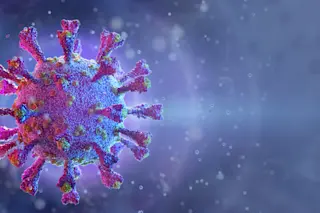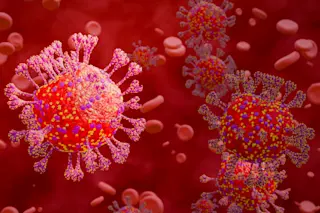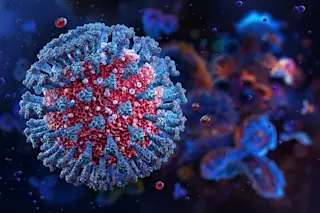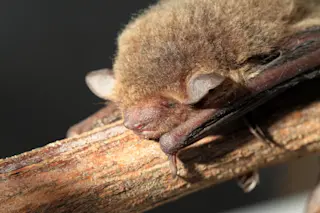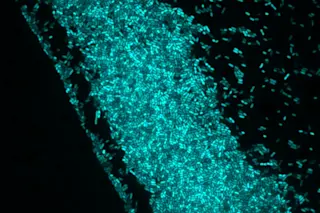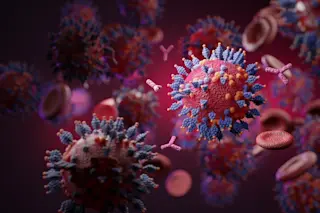
In a cluttered lab annex at Michigan State University, two entomologists huddle in front of a 25-inch computer monitor aglow with a jumble of fuzzy antennae, bent legs, and multilensed eyes. Dressed in a white coat, his face lighted by the screen, Vladimir Kokoza works his keyboard and mouse to bring an insect's body parts into focus. Soon an image emerges of an Aedes aegypti mosquito enlarged to horror film dimensions. Leaning over Kokoza's shoulder, Alexander Raikhel points to the insect's eyes, noticeably a deep red thanks to genetic manipulation. Raikhel's pale face softens into a paternal smile. "These little Aedes are one step toward making a series of custom-made mosquitoes," he says.
Bloodsucking mosquitoes are perhaps Earth's most persistent scourge, delivering malaria, dengue, yellow fever, and a host of other diseases each year to more than half a billion people and killing between 2 million and 3 million. In the United States alone, billions of gallons of pesticides are sprayed each year in an effort to eradicate the tiny beasts. But at Raikhel's East Lansing lab, mosquitoes are treated with lavish care. They occupy safe, temperature- controlled rooms. They are protected from predators and disease. And Raikhel's associate, Kokoza, on occasion offers up his own flesh for feedings, coaxing even the feeble ones to partake of his blood.

Nothing is too good for these laboratory mosquitoes, because Raikhel and Kokoza believe they can be transformed from disease vectors into disease fighters. Through various forms of genetic manipulation, Raikhel and his competitors at a handful of other labs are trying to deprive mosquitoes of their ability to spread parasitic infections. Raikhel's strategy is to boost the immune response of mosquitoes so that they kill pathogens they would normally harbor and pass on to humans. Red eyes serve as markers in his laboratory brood of modified Aedes mosquitoes for a designer gene that triggers heightened production of the immune protein defensin, which recognizes many microbes and destroys them.
Within a few years, descendants or cousins of these transgenic mosquitoes could be among the first man-made animals purposely set loose in a natural environment. Raikhel's ultimate goal is to have mosquitoes armed with extra defensin, or other immune factors like it, interbreed with and displace wild mosquito populations, in the process stopping the spread of disease to humans. "We could make mosquitoes that are genetically dominant in the wild and yet incapable of transmitting disease," says Raikhel. "That's our hope anyway."
Of course, genetic manipulation is not without risk. At the very least, transgenic mosquitoes could turn out to be an expensive boondoggle. At worst, they may be only temporarily effective and could lead to epidemics as wild mosquitoes rebound and begin biting people who have lost protective immunities over time. The closer Raikhel and other mosquito makers get to success, the more uneasy skeptics become. "Transgenic mosquitoes will mutate," warns entomologist Andrew Spielman of the Harvard School of Public Health. "Just how, we don't know."
Entomologists and cell biologists began toying with the idea of creating a designer mosquito nearly two decades ago. "Most of the tools we have to deal with mosquitoes— medicines and insecticides— go back to World War II or just after it," notes entomologist Frank H. Collins of the Center for Tropical Disease Research and Training at Notre Dame University. And they were proving increasingly ineffective. For example, Plasmodium falciparum, the most dangerous of the protozoans that cause the deadliest mosquito-borne disease— malaria— had grown resistant to many drugs.
Alexander Raikhel (left) grew up in Eastern Siberia. He studied tick-borne diseases until he moved to the United States in 1979, when he became interested in mosquitoes. Vladimir Kokoza (right) also grew up in Siberia. The two entomologists met at a conference in 1992.


An even more vexing problem was the tenacity of mosquitoes, which predate humans on Earth and possess an uncanny ability to adapt to almost any environment. One African desert-dwelling species lays its often germ-infected eggs in the sand, where they lie dormant for decades until a freak rain. Then they hatch and take to the air, ready to infect humans. Other species living closer to people no longer seek out ponds and swamps in which to breed; instead, they lay their eggs opportunistically. Aedes aegypti, for example, breeds in tires, bottles, and tin cans. As early as the 1950s, scientists noted that many mosquitoes could withstand the most potent insecticide, DDT.
Mosquitoes are not created equal, however. Only 100 or so of the 2,500 mosquito species are known to transfer pathogenic germs to people. Most don't feed on humans at all, preferring the blood of animals. Of those that do feed on human blood, many kill off the pathogens they acquire before they can pass them on in another bite. By the mid-1980s Raikhel and others began searching for clues about how these "incompetent" mosquitoes stop the transmission of disease, as well as how that trait might be transferred and made genetically dominant in more dangerous species. First, researchers set out to try the simplest manipulation— inserting a gene for eye color— to prove that a mosquito could be altered. They chose Aedes aegypti, a carrier of yellow fever and dengue viruses, because it is easy to breed. Success seemed guaranteed based on experience with another popular laboratory insect, Drosophila; labs had been creating new models of the common fruit fly for decades. Surprisingly, the mosquito makers ran into trouble. "For about five years, every time we went to meetings we did nothing but talk about our failures," says Raikhel.
At the University of California at Irvine, recalls geneticist Anthony James, "we tried maybe 80 or 90 experiments involving hundreds of thousands of mosquitoes and just couldn't get it to work right." The problem turned out to be the scientists' choice of a transposable element, or transposon. These small pieces of DNA can worm their way into a living organism's chromosomes, and genetic researchers use them to insert new genes in plants and animals.
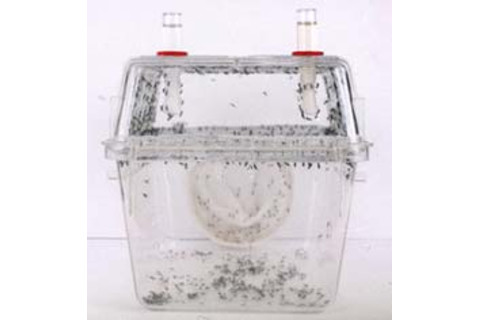
Poppy-seed-sized eggs are removed from the mosquitoes' Plexiglas dwelling and carefully injected with new DNA under a microscope.
Mosquito engineers were working with a transposable element called P, which had been used for years in Drosophila. "It turns out that the fruit fly had several host factors— proteins— that facilitated [entry of] P," says James.
A major break came in the mid-1990s when molecular geneticist David O'Brochta of the University of Maryland Biotechnology Institute discovered another transposon in houseflies that he named Hermes after the Greek messenger god. Other researchers subsequently identified three more— mariner, Minos, and piggyBac. In 1998, James hurdled the barrier: using Hermes to ferry new genetic material into the mosquito genome, he produced an Aedes aegypti with red eyes.
James's success galvanized work at other labs. Raikhel quickly focused on boosting the mosquito's manufacture of defensin. Like many animals, including humans, mosquitoes produce the protein to ward off invasion by bacteria; defensin punches holes in bacterial cell walls, destroying them. But more-evolved parasites, such as the protozoans that cause malaria, have over the eons developed what Raikhel calls "a well-oiled system" that allows them to escape detection when ingested by a mosquito and flourish inside the insect without harming it. Eventually the parasites migrate to the salivary glands, where they wait patiently for the mosquito to alight on human flesh and transfer them to a new host, where they can wreak real havoc.
Raikhel figured that if he could manipulate mosquitoes to produce defensin whenever they dined on blood, it would kill parasites before they could reach the salivary glands. First, he found a gene that is switched on by a blood meal. Then he combined it with the gene that directs defensin manufacture. Next, he needed to insert this new chimeric gene into Aedes aegypti. Raikhel and his team quickly set up an assembly line to accomplish the dauntingly delicate task. Poppy-seed-sized eggs laid by the mosquitoes in tiny Plexiglas cages were carefully harvested and placed under microscopes. Steady-handed technicians pierced each shell with an ultrafine needle crafted on-site and injected the new DNA— the transposon Hermes carrying the chimeric gene and a marker eye-color gene. Then the eggs were incubated in shallow dishes filled with warm water. Larvae emerged, developed into pupae, and hatched as adult mosquitoes. These mosquitoes then mated with each other. When their offspring hatched, lab assistants scanned trays of the new insects under a microscope, searching for the telltale red eyes that would indicate a transgenic mosquito had been born.
"One of the guys here was a very fast worker," says Kokoza. "He just took the trays with hundreds of hatched mosquitoes, and if he didn't see red, he froze them." But hidden among the glassy wings and soft bodies one day was a pair of red eyes. They weren't discovered until the creature was dead. "He said: 'No problem. We'll make another one,' " says Kokoza with a heavy sigh. "It took us about six months."
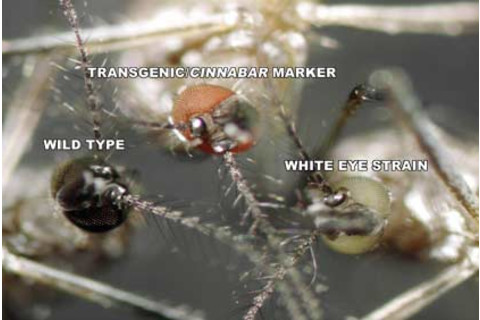
The eyes of these Aedes aegypti mosquitoes tell the tale of genetic manipulation. The black-eyed insect (left) is wild and untouched. The white-eyed mosquito (right) is a special lab strain into which the new genetic material is injected. If the new DNA takes, the eyes of succeeding generations will show up red, as in the mosquito at center.
Once the red-eyed mosquitoes began to turn up in greater numbers, Raikhel confirmed that he had made the first functional transgenic mosquito— an insect that not only looked different but acted in a novel way, producing defensin at every blood feeding and transferring that trait to generation after generation. "We had a good idea, but it was built on work done at many labs," says Raikhel. "The important thing is that after 15 years, making transgenic mosquitoes is becoming routine. Now we can address more questions."
The primary challenge facing scientists bent on making a useful mosquito is to engineer one incapable of transmitting malaria. For that they will have to turn their attention away from Aedes aegypti, the laboratory favorite, to Anopheles gambia, the chief carrier of malaria-causing Plasmodia, and therefore the most dangerous mosquito on Earth. Although Anopheles is more difficult to breed and maintain, its genome is well understood. And Raikhel, for one, is confident the gene that stimulates defensin production in Aedes can be inserted in Anopheles.
Meanwhile, Raikhel's competitors are investigating other possibilities. Anthony James has successfully inserted a gene in Aedes that normally stimulates production of malarial antibodies in mice and eventually hopes to try his luck with Anopheles. Marcelo Jacobs-Lorena at Case Western Reserve School of Medicine is exploring the coaxing of lab mosquitoes to make peptides that would coat their salivary glands and block parasites from entering. Frank Collins and others are focused on creating a mutant Anopheles that will kill the parasite by "melanizing" it with a hard shell of pigment. The development of a transgenic Anopheles with the ability to kill malaria and dominate the mosquito gene pool appears to be just a matter of time.
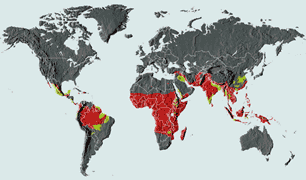
Of the many diseases mosquitoes carry— dengue, yellow fever, West Nile fever, Rift Valley fever— malaria is the deadliest. It infects at least 300 million people each year and claims 3,000 lives a day.
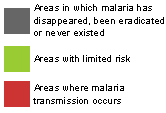
As Raikhel and others move closer to their goal, they are raising the stakes in a growing argument over whether it is practicable or wise to create such genetically engineered creatures and set them loose in the environment. To begin with, transgenic mosquitoes would need to be created for each of the estimated 100 species that carry illnesses that affect humans. To further complicate matters, strains of these mosquitoes vary from place to place. And then there's the problem of multiple vectors. In certain parts of the world, some diseases have primary, secondary, and even tertiary carriers. "In Mopti, a village in Mali, there are seven different mosquitoes that transmit malaria," says Andrew Spielman. Each of those seven species is genetically different, and to fight malaria, the genetic engineers may have to create seven different transgenic mosquitoes. Even if the mosquito makers are successful, Spielman adds, experience with other animals shows that transposons can lose their effectiveness.
If these problems aren't enough, and the mosquito engineers somehow produce the perfect insect for every occasion, where is the village or town that wants a million or so biting pests released? Five decades in the field have led Spielman to conclude that it would be "almost certainly impractical" to release mosquitoes in any place where people live. In India in the 1970s, Spielman recalls, the World Health Organization sent teams to small villages to release thousands of male mosquitoes that had been sterilized by radiation.
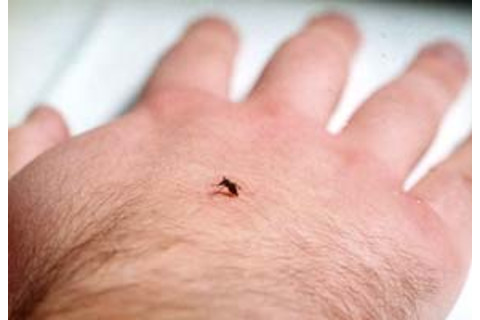
Raikhel's team keeps protective watch on the modified Aedes, sometimes even letting the tiny insects bite them and feed on their blood.
Theoretically the sterile males would mate with females and, since mosquitoes generally copulate just once in a lifetime, there would be no offspring. Soon after the project began, however, rumor spread that it was a foreign government's plot to sterilize people via mosquito bites. The scientists were driven away by angry residents, and the project was canceled. In today's world, where genetically modified vegetables spark protest, any effort to deliver truckloads of transgenic insects into people's backyards "ain't gonna work," Spielman says.
The highly respected Spielman's words of caution are taken seriously. But the cell biologists who work on transgenics wonder if they aren't encountering a generation gap. "The older guys have seen a lot of ideas fail and are skeptical," notes James. "I understand that. But it doesn't mean we don't try something new." In Collins's view, malaria is so bad in certain parts of the world that radical solutions will be welcome in many places. "Any idea, whether it's transgenic mosquitoes or something else, will have to be explained very openly and completely. But if you go to a village where a quarter of the kids die from malaria and a lot of the adults are sick all the time, I don't think you'll get much argument."
Raikhel agrees. The quest for a safe man-made mosquito, he insists, offers the best strategy for defeating one of the world's oldest and deadliest pests. "Our enemies are constantly finding new ways to defend themselves," he says. "So must we."






